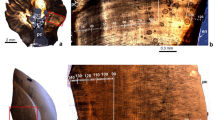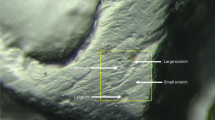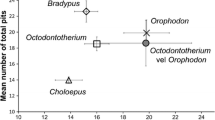Abstract
This paper investigates the potential of mesoscale tooth wear (mesowear, chipping, facets, and other wear attributes) in rodents as a proxy for Arctic habitat. It presents a pilot study of narrow-headed voles, Microtus gregalis, at three sites along a latitudinal gradient of ecological subzones in the Yamal Peninsula of the Russian Arctic. These sites include Kharp in the forest–tundra ecotone, Erkuta in the low Arctic, and Sabetta at the border between the low and the high Arctic. A total of 117 specimens were included and eight variables were used to characterize mesoscale tooth wear. Results show significant differences between the sites, suggesting that these variables can distinguish populations from different subzones. Kharp has the flattest tooth wear, whereas Sabetta has the most M1 occlusal relief and dentin exposure. These results are consistent with and interpreted in the light of published experimental work on captive voles. In addition, the Kharp sample has the tallest M1 crowns, whereas Sabetta has the most vertically implanted M1s. The general directional trends toward separation of values by latitude of samples suggests that mesoscale wear in hypselodont rodents (those with open-rooted, ever-growing molar teeth) reflects variation in food abrasivity and, by extension, may be valuable for tracking habitat and ecological changes in the Arctic.




Similar content being viewed by others
Data availability
All raw data presented in this study are presented in Appendix II. The original specimens are curated and kept at the Arctic Research Station in Labytnangi, Russia.
References
Ackermans NL (2020) The history of mesowear: a review. Peerj 8:e8519
Ackermans NL, Martin LF, Codron D, Hummel J, Kircher PR, Richter H, Kaiser TM, Clauss M, Hatt JM (2020) Mesowear represents a lifetime signal in sheep (Ovis aries) within a long-term feeding experiment. Palaeogeogr Palaeocl 553:109793
Ackermans NL, Winkler DE, Schulz-Kornas E, Kaiser TM, Muller DWH, Kircher PR, Hummel J, Clauss M, Hatt JM (2018) Controlled feeding experiments with diets of different abrasiveness reveal slow development of mesowear signal in goats (Capra aegagrus hircus). J Exp Biol. https://doi.org/10.1242/jeb.186411.
Alfredsson H, Clymans W, Hugelius G, Kuhry P, Conley DJ (2016) Estimated storage of amorphous silica in soils of the circum-Arctic tundra region. Glob Biogeochem Cycle 30:479–500
Ballová Z, Pekárik L, Píš V, Šibík J (2019) How much do ecosystem engineers contribute to landscape evolution? A case study on Tatra marmots. CATENA 180:104121
Bashenina N (1962) Ecology of common vole with some features of its geographical variability (In Russian). Moscow University Press, Moscow
Borodin AV (2009) Guide on teeth of voles of ural and western Siberia (late Pleistocene—Today) (In Russian). Ural Branch of the Russian Academy of Sciences, Ekaterinburg
Burgman JHE, Leichliter J, Avenant NL, Ungar PS (2016) Dental microwear of sympatric rodent species sampled across habitats in southern Africa: Implications for environmental influence. Int Zool 11:111–127
Calandra I, Labonne G, Schulz-Kornas E, Kaiser TM, Montuire S (2016) Tooth wear as a means to quantify intra-specific variations in diet and chewing movements. Sci Rep 6:34037
Caporale SS, Ungar PS (2016) Rodent incisor microwear as a proxy for ecological reconstruction. Palaeogeogr Palaeocl 446:225–233
Carey JC, Fulweiler RW (2012) The terrestrial silica pump. PLoS ONE 7:e52932
Christensen TR, Payne J, Doyle G, Ibarguchi G, Taylor NM, Schmidt M, Gill M, Svoboda M (2013) The arctic terresetrial biodiversity monitoring plan. CAFF International Secretariat, Akureyri
Conover WJ, Iman RL (1981) Rank transformations as a bridge between parametric and nonparametric statistics. Am Stat 35:124–129
Constantino PJ, Markham K, Lucas PW (2012) Tooth chipping as a tool to reconstruct diets of great apes (Pongo, Gorilla, Pan). Int J Primatol 33:661–672
Cook RJ, Farewell VT (1996) Multiplicity considerations in the design and analysis of clinical trials. J R Stat Soc A 159:93–110
Danowitz M, Hou SK, Mihlbachler M, Hastings V, Solounias N (2016) A combined-mesowear analysis of late Miocene giraffids from North Chinese and Greek localities of the Pikermian Biome. Palaeogeogr Palaeocl 449:194–204
Dunaeva TN (1948) Comparative ecology of the tundra voles of Yamal Peninsula. (In Russian). Proc Inst Geogr USSR Acad Sci 41:78–143
Ehrich D, Cerezo M, Rodnikova AY, Sokolova NA, Fuglei E, Shtro VG, Sokolov AA (2017) Vole abundance and reindeer carcasses determine breeding activity of Arctic foxes in low Arctic Yamal, Russia. BMC Ecol 17:32
Ehrich D, Schmidt NM, Gauthier G, Alisauskas R, Angerbjorn A, Clark K, Ecke F, Eide NE, Framstad E, Frandsen J, Franke A, Gilg O, Goiroux M-A, Henttonen H, Bierger H, Ims RA, Kataev GD, Kharitonov SP, Krebs CJ, Killengreen ST, Lanctot RB, Lecomte N, Menyushina IR, Morris DW, Morrisson G, Oksanen L, Oksanen T, Olofsson J, Pokrovsky IG, Popov IY, Reid D, Roth JD, Samelius G, Sittler B, Sleptsov SM, Smith P, Sokolov AA, Sokolova NA, Soloviev MY, Solovyeva D (2020) Documenting lemming population change in the Arctic: can we detect trends? Ambio 49:786–800
Eronen JT, Puolamaki K, Liu L, Lintulaakso K, Damuth J, Janis C, Fortelius M (2010) Precipitation and large herbivorous mammals I: estimates from present-day communities. Evol Ecol Res 12:217–233
Fortelius M, Solounias N (2000) Functional characterization of ungulate molars using the abrasion-attrition wear gradient: a new method for reconstructing paleodiets. Am Mus 3301:1–36
Fraser D, Theodor JM (2010) The use of gross dental wear in dietary studies of extinct lagomorphs. J Paleontol 84:720–729
Fufachev IA, Ehrich D, Sokolova NA, Sokolov VA, Sokolov AA (2019) Flexibility in a changing arctic food web: can rough-legged buzzards cope with changing small rodent communities? Glob Change Biol 25:3669–3679
Gagnon M, Chew AE (2000) Dietary preferences in extant African Bovidae. J Mammal 8:490–511
Gailer JP, Kaiser TM (2014) Common solutions to resolve different dietary challenges in the ruminant dentition: the functionality of bovid postcanine teeth as a masticatory unit. J Morphol 275:328–341
Gilg O, Sittler B, Hanski I (2009) Climate change and cyclic predator–prey population dynamics in the high Arctic. Glob Change Biol 15:2634–2652
Green JL, Croft DA (2018) Using dental mesowear and microwear for dietary inference: a review of current techniques and applications: reconstructing Cenozoic terrestrial environments and ecological communities. In: Croft DA, Su D, Simpson SW (eds) Methods in paleoecology: reconstructing cenozoic terrestrial environments and ecological communities. Springer International Publishing, Cham, pp 53–73
Hua LC, Ungar PS, Zhou ZR, Ning ZW, Zheng J, Qian LM, Rose JC, Yang D (2015) Dental development and microstructure of bamboo rat incisors. Biosurf Biotribol 1:263–269
Ims RA, Yoccoz NG, Killengreen ST (2011) Determinants of lemming outbreaks. Proc Natl Acad Sci U S A 108:1970–1974
Janis CM (1988) An estimation of tooth volume and hypsodonty indices in ungulate mammals, and the correlation of these factors with dietary preference. In: Russell DE, Santoro J-P, Sigogneau-Russell D (eds) Teeth revisited: proceedings of the VIIth international symposium on dental morphology, Paris, 1986. Muséum national d'Histoire naturelle, Paris, pp 367–387
Kaiser TM, Fortelius M (2003) Differential mesowear in occluding upper and lower molars: opening mesowear analysis for lower molars and premolars in hypsodont horses. J Morphol 258:67–83
Kaiser TM, Muller DWH, Fortelius M, Schulz E, Codron D, Clauss M (2013) Hypsodonty and tooth facet development in relation to diet and habitat in herbivorous ungulates: implications for understanding tooth wear. Mammal Rev 43:34–46
Kopein KI (1958) Materials on the biology of the siberian lemming and the narrow-headed vole (in Russian). Bul MOIP Ural Dept 1:109–133
Kropacheva JE, Smirnov NG, Markova EA (2012) Individual age and odontologic characteristics of root vole. Dokl Biol Sci 446:302–305
Kropacheva YE, Sibiryakov PA, Smirnov NG, Zykov SV (2017) Variants of tooth mesowear in Microtus voles as indicators of food hardness and abrasiveness. Russ J Ecol 48:73–80
Legagneux P, Gauthier G, Berteaux D, Bety J, Cadieux MC, Bilodeau F, Bolduc E, McKinnon L, Tarroux A, Therrien JF, Morissette L, Krebs CJ (2012) Disentangling trophic relationships in a High Arctic tundra ecosystem through food web modeling. Ecology 93:1707–1716
Lucas PW, van Casteren A, Al-Fadhalah K, Almusallam AS, Henry AG, Michael S, Watzke J, Reed DA, Diekwisch TGH, Strait DS, Atkins AG (2014) The role of dust, grit and phytoliths in tooth wear. Ann Zool Fenn 51:143–152
MacFadden BJ (1997) Origin and evolution of the grazing guild in New World terrestrial mammals. Trends Ecol Evol 12:182–187
Markova EA, Smirnov NG, Kourova TP, Kropacheva YE (2013) Ontogenetic variation in occlusal shape of evergrowing molars in voles: an intravital study in Microtus gregalis (Arvicolinae, Rodentia). Mamm Biol 78:251–257
Martin LF, Krause L, Ulbricht A, Winkler DE, Codron D, Kaiser TM, Muller J, Hummel J, Clauss M, Hatt JM, Schulz-Kornas E (2020) Dental wear at macro- and microscopic scale in rabbits fed diets of different abrasiveness: a pilot investigation. Palaeogeogr Palaeocl 556:109886
Martin LF, Winkler D, Tutken T, Codron D, De Cuyper A, Hatt JM, Clauss M (2019) The way wear goes: phytolith-based wear on the dentine-enamel system in guinea pigs (Cavia porellus). Proc R Soc B Biol Sci 286:20191921
Mihlbachler MC, Solounias N (2006) Coevolution of tooth crown height and diet in oreodonts (Merycoidodontidae, Artiodactyla) examined with phylogenetically independent contrasts. J Mam Evol 13:11–36
Morris DW, Dupuch A (2012) Habitat change and the scale of habitat selection: shifting gradients used by coexisting arctic rodents. Oikos 121:975–984
Müller J, Clauss M, Codron D, Schulz E, Hummel J, Fortelius M, Kircher P, Hatt JM (2014) Growth and wear of incisor and cheek teeth in domestic rabbits (Oryctolagus cuniculus) fed diets of different abrasiveness. J Exp Zool A Ecol Genet Physiol 321:283–298
Myllymäki A, Paasikallio A, Pankakoski E, Kanervo V (1971) Removal experiments on small quadrats as a mean of rapid assessment of the abundance of small mammals. Ann Zool Fenn 8:177–185
Nelson S, Badgley C, Zakem E (2005) Microwear in modern squirrels in relations to diet. Palaeontol Electron 8:1–15
Pal’chekh NA, Mal’kova MG, Kuz’min IV, Yakimenko VV (2003) The structure of narrow-skulled vole (Microtus gregalis Pall.) colonies in western Siberia. Russ J Ecol 34:327–331
Piperno DR (2006) Phytoliths: a comprehensive guide for archaeologists and paleoecologists. Alta Mira Press, Oxford
Prugh LR, Brashares JS (2012) Partitioning the effects of an ecosystem engineer: kangaroo rats control community structure via multiple pathways. J Anim Ecol 81:667–678
Przybylak R, Wyszyński P (2020) Air temperature changes in the Arctic in the period 1951–2015 in the light of observational and reanalysis data. Theor Appl Climatol 139:75–94
Rabenold D, Pearson OM (2014) Scratching the surface: A critique of Lucas et al. (2013)’s conclusion that phytoliths do not abrade enamel. J Hum Evol 74:130–133
Rensberger JM (1973) Occlusion model for mastication and dental wear in herbivorous mammals. J Paleontol 47:515–528
Rensberger JM (1986) Early chewing mechanisms in mammalian herbivores. Paleobiology 12:474–494
Rivals F, Mihlbachler MC, Solounias N (2007) Effect of ontogenetic-age distribution in fossil and modern samples on the interpretation of ungulate paleodiets using the mesowear method. J Vert Paleontol 27:763–767
Rivals F, Rindel D, Belardi JB (2013) Dietary ecology of extant guanaco (Lama guanicoe) from Southern Patagonia: seasonal leaf browsing and its archaeological implications. J Archaeol Sci 40:2971–2980
Robinet C, Merceron G, Candela AM, Marivaux L (2020) Dental microwear texture analysis and diet in caviomorphs (Rodentia) from the Serra do Mar Atlantic forest (Brazil). J Mammal 101:386–402
Rodrigues HG, Merceron G, Viriot L (2009) Dental microwear patterns of extant and extinct Muridae (Rodentia, Mammalia): Ecological implications. Naturwissenschaften 96:537–542
Sanson GD, Kerr SA, Gross KA (2007) So silica phytoliths really wear mammalian teeth? J Archaeol Sci 34:526–531
Schmidt-Kittler N (2002) Feeding specializations in rodents. Senckenb Lethaea 82:141–152
Schour I, Medak H (1951) Experimental increase in rate of eruption and growth of rat incisor by eliminating attrition. J Dent Res 30:521
Schulz E, Fraas S, Kaiser TM, Cunningham PL, Ismail K, Wronski T (2013) Food preferences and tooth wear in the sand gazelle (Gazella marica). Mamm Biol 78:55–62
Smirnov NG, Kropacheva JE (2015) Patterns of lateral wear facets on molar teeth of voles (Arvicolinae). Dokl Biol Sci 460:20–22
Sokolov AA, Sokolova NA, Ims RA, Brucker L, Ehrich D (2016) Emergent rainy winter warm spells may promote boreal expansion into the Arctic. Arctic 69:121–129
Sokolov V, Ehrich D, Yoccoz NG, Sokolov A, Lecomte N (2012) Bird communities of the arctic shrub tundra of Yamal: habitat specialists and generalists. PLoS ONE 7:e50335
Sokolova NA, Sokolov AA, Ims RA, Skogstad G, Lecomte N, Sokolov VA, Yoccoz NG, Ehrich D (2014) Small rodents in the shrub tundra of Yamal (Russia): density dependence in habitat use? Mamm Biol 79:306–312
Solounias N, Tariq M, Hou SK, Danowitz M, Harrison M (2014) A new method of tooth mesowear and a test of it on domestic goats. Ann Zool Fenn 51:111–118
Sponheimer M, Reed KE, Lee-Thorp JA (1999) Combining isotopic and ecomorphological data to refine bovid paleodietary reconstruction: a case study from the Makapansgat Limeworkshominin locality. J Hum Evol 36:705–718
Team C (2003) Circumpolar Arctic Vegetation Map, scale 1:7 500,000. Conservation of Arctic Flora and Fauna (CAFF) Map No. 1. U.S. Fish and Wildlife Service, Anchorage, AK
Towle I, Irish JD, De Groote I (2017) Behavioral inferences from the high levels of dental chipping in Homo naledi. Am J Phys Anthropol 164:184–192
Townsend KEB, Croft DA (2008) Enamel micrower in caviomorph rodents. J Mammal 89:730–743
Tschumi M, Ekroos J, Hjort C, Smith HG, Birkhofer K (2018) Rodents, not birds, dominate predation-related ecosystem services and disservices in vertebrate communities of agricultural landscapes. Oecologia 188:863–873
Ulbricht A, Maul LC, Schulz E (2015) Can mesowear analysis be applied to small mammals? A pilot-study on leporines and murines. Mamm Biol 80:14–20
Ungar PS (2017) Evolution’s bite: a story of teeth, diet, and human origins. Princeton University Press, Princeton
van der Meulen AJ (1973) Middle Pleistocene smaller mammals from the Monte Peglia (Orvieto, Italy) with special reference to the phylogeny of Microtus (Arvicolidae, Rodentia). Quaternaria 17:1–144
Walker DA, Raynolds MK, Daniels FJA, Einarsson E, Arve E, Gould WA, Kaitenin AE, Kholod SS, Markon CJ, Melnikov ES, Moskalenko NG, Talbot SS, Yurtsev BA (2005) The circumolar arctic vegetation map. J Veg Sci 16:267–282
Winkler DE, Schulz-Kornas E, Kaiser TM, De Cuyper A, Clauss M, Tutken T (2019) Forage silica and water content control dental surface texture in guinea pigs and provide implications for dietary reconstruction. Proc Natl Acad Sci U S A 116:1325–1330
Wolfe SA, Nickling WG (1993) The protective role of sparse vegetation in wind erosion. Prog Phys Geogr 17:50–68
Zhang YM, Zhang ZB, Liu JK (2003) Burrowing rodents as ecosystem engineers: the ecology and management of plateau zokors Myospalax fontanierii in alpine meadow ecosystems on the Tibetan Plateau. Mammal Rev 33:284–294
Zuri I, Kaffe I, Dayan D, Terkel J (1999) Incisor adaptation to fossorial life in the blind mole-rat, Spalax ehrenbergi. J Mammal 80:734–741
Acknowledgements
We are grateful to the reviewers for their helpful comments and suggestions on an earlier draft of this paper. We thank Violetta Filippova and Svetlana Sokovnina for discussions and Olivier Gilg for making the connection that established this collaboration.
Funding
NAS, IF and AAS were supported through grant of Russian Foundation for Basic Research No: 18-05-60261, by the Russian Center of Development of the Arctic, “Yamal-LNG” company and Government of the Yamal Nenets Autonomous District. PSU developed the collaboration through support from US National Science Foundation Award No: 1927793.
Author information
Authors and Affiliations
Contributions
PSU, AAS, and NAS conceived the project, analyzed the data and wrote the paper. NAS, IF, and AAS collected the specimens analyzed in this paper. PSU and JP generated the data used in this paper.
Corresponding author
Ethics declarations
Conflict of interest
The authors have no conflicts of interest or competing interests.
Ethics approval
No ethics approvals were required to conduct this research.
Additional information
Handling editor: Eva Bärmann.
Publisher's Note
Springer Nature remains neutral with regard to jurisdictional claims in published maps and institutional affiliations.
Electronic supplementary material
Below is the link to the electronic supplementary material.
Rights and permissions
About this article
Cite this article
Ungar, P.S., Sokolova, N.A., Purifoy, J. et al. Assessing molar wear in narrow-headed voles as a proxy for diet and habitat in a changing Arctic. Mamm Biol 101, 137–151 (2021). https://doi.org/10.1007/s42991-020-00079-x
Received:
Accepted:
Published:
Issue Date:
DOI: https://doi.org/10.1007/s42991-020-00079-x




